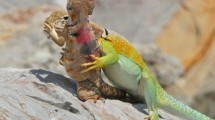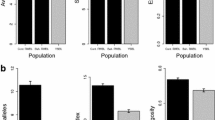Abstract
Studies have revealed an unsuspected complexity in social systems within a few lizard species, including group living, long-term monogamy and individual recognition of partners or offspring. Comparisons among these species and their relatives could provide valuable insights, allowing us to investigate traits that are shared across social systems and identify general principles relating to the evolution of sociality. The endangered pygmy bluetongue lizard, Tiliqua adelaidensis, is a member species in the Egernia group, but is thought to show a more solitary social structure than other members in this group. Within this study we used microsatellite markers to determine the mating system of T. adelaidensis. Unlike many other species in the Egernia group, we found a predominately promiscuous mating system in T. adelaidensis. We detected multiple paternity in 75 % of litters. Of the 70 males identified as having fathered juveniles, only 5 were identified as mating with the same female in more than 1 year and only 3 were identified as the father of juveniles with the same female in consecutive years. The genetic evidence suggested that partners were chosen randomly with respect to the level of relatedness among neighbouring lizards. However, mated lizards were geographically closer to each other than expected by random chance. Multiple paternities rely on the opportunity for males to encounter multiple females during the period when they are receptive to mating, and this may depend on population densities. Drivers for the polygamous mating system may be the single occupancy burrow and the central place territorial defence of those burrows in T. adelaidensis. We propose a fourth mating system for the Egernia group: polygyny within stable non-social colonies.

Similar content being viewed by others
References
Armstrong G, Reid J (1992) The rediscovery of the Adelaide pygmy bluetonge lizard Tiliqua adelaidensis; (Peters1863). Herpetofauna 22:3–6
Bull CM (2000) Monogamy in lizards. Behav Processes 51:7–20
Bull CM, Baghurst BC (1998) Home range overlap between mothers and their offspring in the sleepy lizard, Tiliqua rugosa. Behav Ecol Sociobiol 42:357–362
Bull CM, Cooper SJB (1999) Relatedness and avoidance of inbreeding in the lizard, Tiliqua rugosa. Behav Ecol Sociobiol 46:367–372
Bull CM, Griffin CL, Bonnett M, Gardner MG, Cooper SJB (2001) Discrimination between related and unrelated individuals in the Australian lizard Egernia striolata. Behav Ecol Sociobiol 50:173–179
Chapple DG (2003) Ecology, life history, and behaviour in the Australian Scincid genus Egernia, with comments on the evolution of complex sociality in lizards. Herpetol Monogr 17:145–180
Chapple DG, Keogh JS (2005) Complex mating system and dispersal patterns in a social lizard, Egernia whitii. Mol Ecol 14:1215–1227
Cogger HG (2000) Reptiles and amphibians of Australia. Reed New Holland, Sydney
Fellows HL (2008) Temporal and spatial dynamics of the endangered pygmy bluetongue lizard, Tiliqua adelaidensis: implications for translocation attempts. Flinders University, Honours
Fellows HL, Fenner AL, Bull CM (2009) Spiders provide important resources for an endangered lizard. J Zool 279:156–163
Fenner AL, Bull CM (2009) Tiliqua adelaidensis (Pygmy Bluetongue lizard) mating behaviour. Herpetol Rev 40:91–92
Fenner AL, Bull CM (2010) Response of the endangered pygmy bluetone lizard to conspecific scats. J Ethol 29:69–77
Fenner AL, Bull CM (2011) Centeral-place territorial defence in a burrow-dwelling skink: aggressive responses to conspecific models in pygmy bluetongue lizards. J Zool 283:45–51
Gardner MG, Cooper SJB, Bull CM, Grant WN (1999) Isolation of microsatellite loci from a social lizard, Egernia stokesii, using a modified enrichment procedure. J Hered 90:301–304
Gardner MG, Bull CM, Cooper SJB (2002) High levels of genetic monogamy in the group-living Australian lizard Egernia stokesii. Mol Ecol 11:1787–1794
Gardner MG, Hugall AF, Donnellan SC, Hutchinson MN, Foster R (2008a) Molecular systematics of social skinks: phylogeny and taxonomy of the Egernia group (Reptilia: Scincidae). Zool J Linn Soc 154:781–794
Gardner MG, Sanchez JJ, Dudaniec RY, Rheinberger L, Smith AL, Saint KM (2008b) Tiliqua rugosa microsatelites: isolation via enrichment and charaterisation of loci for multiplex PCR in T. rugosa and the endangered T. adelaidensis. Conserv Genet 9:233–237
Greenwood PJ (1980) Mating systems, philopatry and dispersal in birds and mammals. Anim Behav 28:1140–1162
Gregory AJ, Kaler RSA, Prebyl TJ, Sandercock BK, Wisely SM (2012) Influence of translocation strategy and mating system on the genetic structure of a newly established population of island Ptarmigan. Conserv Genet 13:465–474
Griffith B, Scott JM, Carpenter JW, Reed C (1989) Translocation as a species conservation tool—status and strategy. Science 245:477–480
Grueber CE, Jamieson IG (2008) Quantifying and managing the loss of genetic variation through the use of pedigrees in a non-captive endangered species. Conserv Genet 9:645–651
Haig SM (1998) Molecular contributions to conservation. Mol Tech Ecol 79:413–425
Holm S (1979) A simple sequentially rejective multiple test procedure. Scand J Stat 6(2):65–70
Hutchinson MN, Milne T, Croft T (1994) Redescription and ecological notes on the Pygmy Bluetongue, Tiliqa adelaidensis (Squamata: Scincida). Trans Royal Soc S Aust 188:217–226
Jones OR, Wang JL (2009) COLONY: a program for parentage and sibship inference from multilocus genotype data. Mol Ecol Resour 10:551–555
Koenig J, Shine R, Shea G (2001) The ecology of an Australian reptile icon: how do blue-tongued lizards (Tiliqua scincoides) survive in suburbia? Wildl Res 28:215–227
Levy E, Kennington WJ, Tomkins JL, Lebas NR (2010) Land clearing reduces geneflow in the granite outcrop-dwelling lizard, Ctenophorus ornatus. Mol Ecol 19:4192–4203
McAlpin S, Duckett P, Stow A (2011) Lizards cooperatively tunnel to construct a long-term home for family members. PLoS ONE 6:1–4
Milne T (1999) Conservation and ecology of the endangered pygmy bluetongue lizard Tiliqua adelaidensis. PhD. thesis, Flinders University of South Australia
Milne T, Bull CM, Hutchinson MN (2002) Characteristics of litters and juvenile dispersal in the endangered Australian skink Tiliqua adelaidensis. J Herpetol 36:110–112
Milne T, Bull CM, Hutchinson MN (2003) Use of burrows by the endangered pygmy blue-tongue lizard, Tiliqua adelaidensis (Scincidae). Wildl Res 30:523–528
O’Connor D, Shine R (2003) Lizards in ‘nuclear families’: a novel reptilian social system in Egernia saxatilis (Scincidae). Mol Ecol 12:743–752
Oliver A, Sachser N (2011) Diversity of social and mating systems in cavies: a review. J Mammal 92:39–53
Raymond M, Rousset F (1995) GENEPOP (Version 1.2): population genetics software for exact tests and ecumenicism. J Hered 86:248–249
Rousset F (2008) genepop’007: a complete re-implementation of the genepop software for Windows and Linux. Mol Ecol Resour 8:103–106
Schofield JA, Fenner AL, Pelgrim K, Bull CM (2012) Male-biased movement in pygmy bluetongue lizards: implications for conservation. Wildl Res 39:677–684
Sigg DP, Goldizen AW, Pople AR (2005) The importance of mating systems in translocation programs: reproductive sucess of released male bridle nailtailed wallabies. Biol Conserv 123:289–300
Smith LM, Burgoyne LA (2004) Collecting, archiving and processing DNA from wildlife samples using FTA(R) databasing paper. BMC Ecol 4:4
Smith AL, Gardner MG, Fenner AL, Bull CM (2009) Restricted gene flow in the endangered pygmy bluetongue lizard (Tiliqua adelaidensis) in a fragmented agricultural landscape. Wildl Res 36:466–478
Stow AJ, Sunnucks P (2004) High mate and site fidelity in Cunningham’s skinks (Egernia cunninghami) in natural and fragmented habitat. Mol Ecol 13:419–430
Stow AJ, Sunnucks P, Briscoe DA, Garnder MG (2001) The impact of habitat fragmentation on dispersal of Cunningham’s skink (Egernia cunninghami): evidence from allelic and genotypic analysis of microsatelites. Mol Ecol 10:867–878
Uller T, Olsson M (2008) Mutliple paternity in reptiles: patterns and processes. Mol Ecol 17:2566–2580
Wang JL (2002) An estimator for pairwise relatedness using molecular markers. Genetics 160:1203–1215
Wang JL (2011) Coancestry: a program for simulating, estimating and analysing relateness and inbreeding coefficients. Mol Ecol Res 11:141–145
Acknowledgments
This research was supported by funds from the Australian Research Council, the Holsworth Wildlife Research Endowment, and the Nature Foundation of South Australia. Thanks to the landholders Richard Sawyers and Chris and Maria Reed, for access to their property and to Travis Hague, Janet Davill and Bill and Pam O’Malley for helping with field work, and to Alison Fitch for lab advice. The study was conducted according to the guidelines of the Flinders University Animal Welfare Committee in compliance with the Australian Code of Practice for the Use of Animals for Scientific Research, permit number E260.
Author information
Authors and Affiliations
Corresponding author
Electronic supplementary material
Below is the link to the electronic supplementary material.
Rights and permissions
About this article
Cite this article
Schofield, J.A., Gardner, M.G., Fenner, A.L. et al. Promiscuous mating in the endangered Australian lizard Tiliqua adelaidensis: a potential windfall for its conservation. Conserv Genet 15, 177–185 (2014). https://doi.org/10.1007/s10592-013-0529-0
Received:
Accepted:
Published:
Issue Date:
DOI: https://doi.org/10.1007/s10592-013-0529-0




